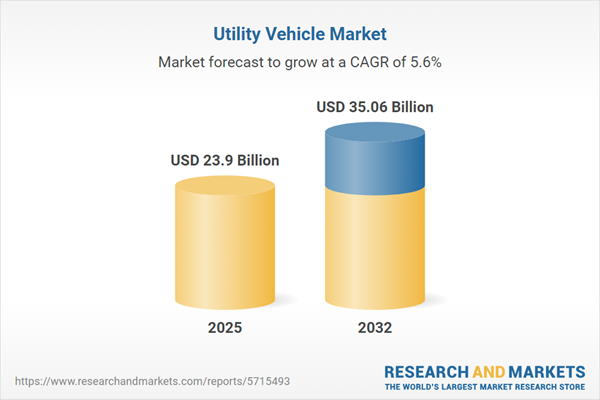Speak directly to the analyst to clarify any post sales queries you may have.
Senior executives across industries are steering mobility strategies as the utility vehicle market transforms through digital integration and innovation. Strategic adaptation to new technologies, sustainability, and evolving operations is increasingly central to success in this dynamic landscape.
Market Snapshot: Utility Vehicle Market Size and Growth Drivers
The global utility vehicle market is on a strong upward trajectory, with growth underpinned by continuous improvements in vehicle design, platform innovation, and the adoption of advanced digital features. This market, projected to reach USD 35.06 billion by 2032 at a CAGR of 5.64%, benefits from a growing emphasis on performance, customization, and operational reliability. Organizations in commercial, industrial, and recreational sectors recognize the value of utility vehicles, integrating them into applications where dependable operations and flexible configurations drive value. As demand for customer-centric solutions rises and mobility innovation accelerates, stakeholders remain well-positioned to capture opportunities in established sectors and new market segments.
Scope & Segmentation of the Global Utility Vehicle Market
The utility vehicle industry is being redefined through technology and strategic diversification, with key segments supporting targeted growth and operational excellence. Executive teams are leveraging segment-specific insights to inform product selection, deployment, and investment direction.
- Drive Type: All Wheel Drive, Four Wheel Drive, and Two Wheel Drive—each configuration addresses unique requirements for terrain adaptability, stability, and performance.
- Vehicle Type: All Terrain Vehicles and Utility Terrain Vehicles—organizations can select vehicles accommodating two, four, or six occupants, supporting a range of personnel and task requirements.
- Payload Capacity: Heavy, Medium, and Light—these categories provide tailored solutions across sectors such as construction, mining, agriculture, and recreation, helping leaders match fleet capabilities to specific project needs.
- Propulsion: Diesel, Electric, Gasoline, and Hybrid options—expanding capabilities for sustainability, operational flexibility, and alignment with local regulatory mandates.
- Application: Agriculture, Construction, Military, Mining, Oil & Gas, and Recreation—each sector brings unique standards and operational goals that utility vehicles address through design and functionality.
- Regions Covered: Americas, Europe, Middle East & Africa, and Asia-Pacific—regional nuances, including local policy, infrastructure investment, and economic factors, influence corporate entry strategies and growth planning.
- Key Companies Profiled: Major players such as Toyota Motor Corporation, Volkswagen Aktiengesellschaft, Stellantis N.V., General Motors Company, Ford Motor Company, Hyundai Motor Company, Renault S.A., Nissan Motor Co., Ltd., Honda Motor Co., Ltd., and Bayerische Motoren Werke Aktiengesellschaft—these companies lead the way in innovation and market expansion.
Key Takeaways for Senior Decision-Makers
- Digital platforms and electrification are reshaping fleet operations, magnifying organizations’ ability to adapt to shifting user expectations and market conditions.
- Environmental and regulatory focus is promoting the adoption of low-emission propulsion systems, contributing to sustainability and efficient asset lifecycle management.
- Formalized partnerships among manufacturers, technology suppliers, and sector specialists are accelerating the integration of advanced solutions tailored to specific industry needs.
- Organizations are enhancing supply chain resilience by diversifying suppliers and prioritizing nearshoring, reducing exposure to trade volatility and procurement challenges.
- Advanced maintenance tools, such as remote data monitoring, increase uptime and engagement, enabling proactive support and streamlined operations.
- Expanded aftermarket options and finance solutions allow organizations of all sizes to access the latest capabilities without delaying adoption due to budget cycles or operational scale.
Tariff Impact: Navigating Trade Pressures
Recent changes in tariff policy within the United States prompt proactive reassessment of sourcing and manufacturing strategies throughout the utility vehicle supply chain. By investing in nearshoring and diversifying geographic sources, companies reduce the risks of supply disruption and rising costs. This approach also encourages localized engineering, increased research and development, and the agility to respond quickly to shifts in international regulations and markets.
Methodology & Data Sources
This analysis draws on comprehensive interviews with senior executives, technical specialists, and procurement leaders in the original equipment manufacturing sector. Findings are informed by policy reviews, technical documentation, and targeted survey data, resulting in a market outlook focused on senior leadership priorities and actionable intelligence.
Why This Report Matters for Executives and Strategy Teams
- Enables leaders to refine product and operational strategies in keeping with current utility vehicle market trends, technology advances, and compliance needs.
- Offers practical guidance on region-specific adoption, technology implementation, and building resilient supply chains for long-term competitive advantage.
- Arms strategy teams with analytical tools to optimize segmentation and support effective go-to-market initiatives across diverse applications and geographies.
Conclusion
Technology, sustainability, and operational adaptability are reconfiguring the utility vehicle sector. Proactive organizations that prioritize these strategies will reinforce their position and create lasting value as the market evolves.
Additional Product Information:
- Purchase of this report includes 1 year online access with quarterly updates.
- This report can be updated on request. Please contact our Customer Experience team using the Ask a Question widget on our website.
Table of Contents
3. Executive Summary
4. Market Overview
7. Cumulative Impact of Artificial Intelligence 2025
List of Figures
Samples

LOADING...
Companies Mentioned
The key companies profiled in this Utility Vehicle market report include:- Toyota Motor Corporation
- Volkswagen Aktiengesellschaft
- Stellantis N.V.
- General Motors Company
- Ford Motor Company
- Hyundai Motor Company
- Renault S.A.
- Nissan Motor Co., Ltd.
- Honda Motor Co., Ltd.
- Bayerische Motoren Werke Aktiengesellschaft
Table Information
| Report Attribute | Details |
|---|---|
| No. of Pages | 197 |
| Published | October 2025 |
| Forecast Period | 2025 - 2032 |
| Estimated Market Value ( USD | $ 23.9 Billion |
| Forecasted Market Value ( USD | $ 35.06 Billion |
| Compound Annual Growth Rate | 5.6% |
| Regions Covered | Global |
| No. of Companies Mentioned | 11 |









